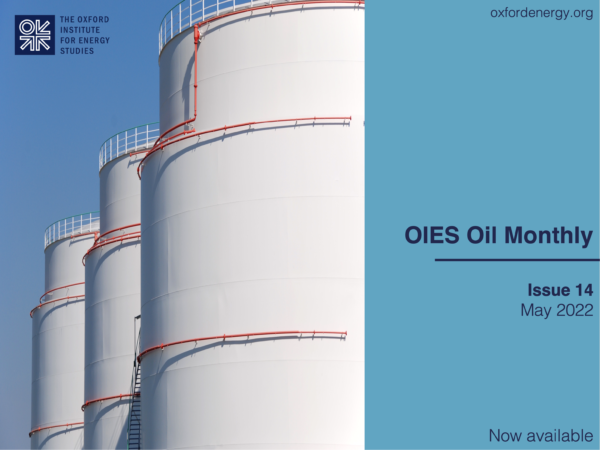OIES Oil Monthly – Issue 14
The new issue of OIES Oil Monthly, including our latest short-term oil market outlook to 2023, is now available.
– The disruption in Russian supplies intensified in April with an estimated loss of 1 mb/d of production m/m. We now expect Russian oil production shut ins to average between 1.6 mb/d and 3 mb/d in H2. Our Reference case sees the disruptions in Russian oil production mainly due to self-sanctioning reaching 1.6 mb/d ending-Q2 2022. Our worst-case under the EU oil ban scenario assumes that the EU-27 reach a deal in Q2 to ban all Russian oil imports by year-end. This could affect over 60% of total Russian oil exports to the region with exports falling to 1.4 mb/d versus 3.5 mb/d observed in April and results in the loss of 4 mb/d of Russian oil production by December 2022.
– Global oil demand growth is revised lower by 0.3 mb/d to 2.3 mb/d in 2022 and remains relatively unchanged to 1.5 mb/d in 2023. Risks to the demand outlook are tilted to the downside. For 2022, geopolitical and growth risks could depress demand growth by another 0.3 mb/d. OECD demand could be hit the hardest accounting for 65% of total declines, with middle distillates and gasoline demand appearing the most severely affected, particularly in Europe and the US.
– Global supply growth is downgraded by 0.73 mb/d to 4.3 mb/d in 2022 and 0.39 mb/d to 1.6 mb/d in 2023. Oil supply tailwinds strengthen on the risk of bigger Russian supply disruptions, limited output response outside Russia due to growth constraints and the dimmed prospects of Iran’s return to the market. A severe disruption in Russian supplies accelerated by a potential EU oil ban that could shut in nearly 4 mb/d of Russian output by year-end, would see a supply gap of 1 mb/d remaining uncovered in 2023 adding further pressure to an already tight market.
– Product markets continue to tighten, with the refining margins at record levels reflecting bottlenecks in the refining sector. EU refineries are ramping up production, but they are facing significant constraints in terms of crude and feedstock availability and high refining costs, while filling the supply gap proves extremely difficult. Product stocks continue to fall to critically low levels exacerbated by Russian refineries cutting runs. Securing supplies from Asia is becoming increasingly challenging, as Asian distillate markets are also tightening on rising demand as economies reopen and stricter limits on China product exports. Pressure has spread to jet fuel as flights restart.
– Our Reference forecast for Brent is downgraded by $5.1/b to $105.4/b in 2022 but lifted by $4.5/b to $99.2/b in 2023. While current crude prices are caught between opposing supply/demand forces, the balance of risks remains skewed on the upside in 2022 at $10.4/b before easing to $2.8/b in 2023. Depending on the size of disruption in Russian supplies and subsequent supply/demand responses, Brent ranges between $101.8/b and $119.3/b in 2022 and $85/b and $116.1/b in 2023, reflective of the severe oil uncertainty that dictates most of our outlook. Oil markets are now more than ever subject to policy decisions and their effectiveness, keeping price volatile and exacerbated by reduced liquidity.
– We project a small 0.4 mb/d surplus in 2022 and a -0.3 mb/d deficit in 2023. With the market failing to build a material surplus in 2022, severe pressure is maintained to the exceptionally thin oil stocks. Despite the increased downward demand pressures, the supply/demand risks to the outlook continue to favor a more tightening supply picture in both 2022 and 2023.
